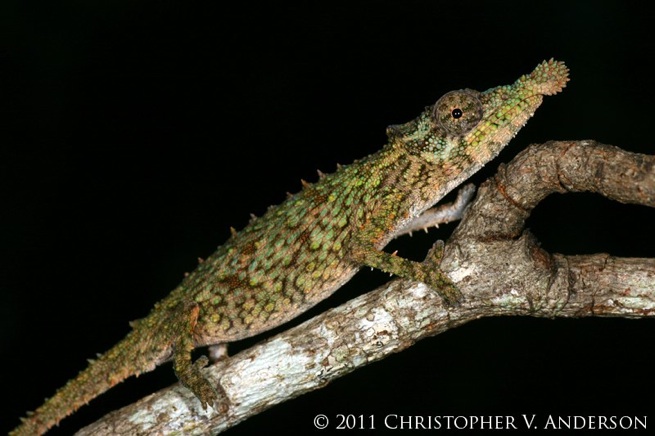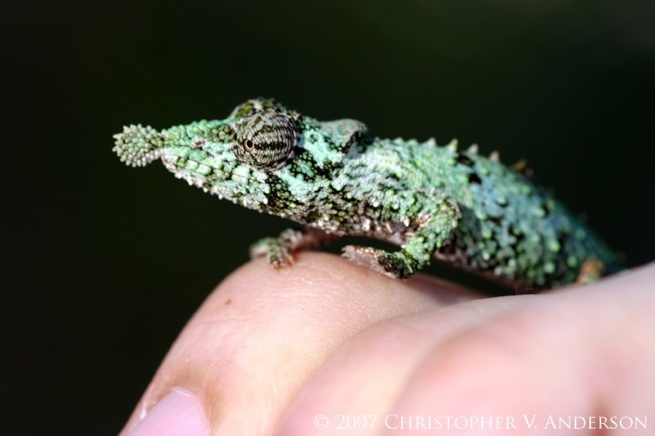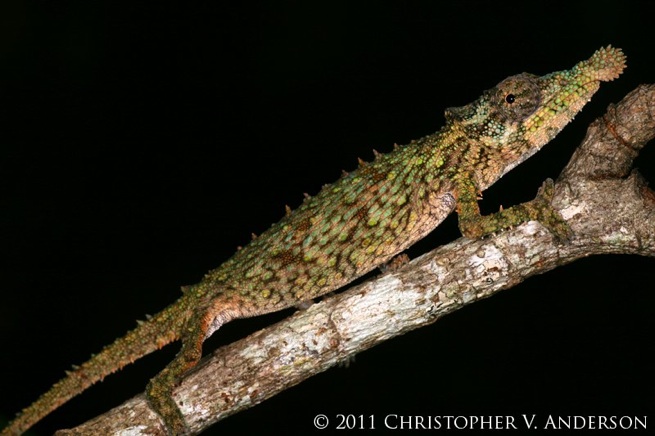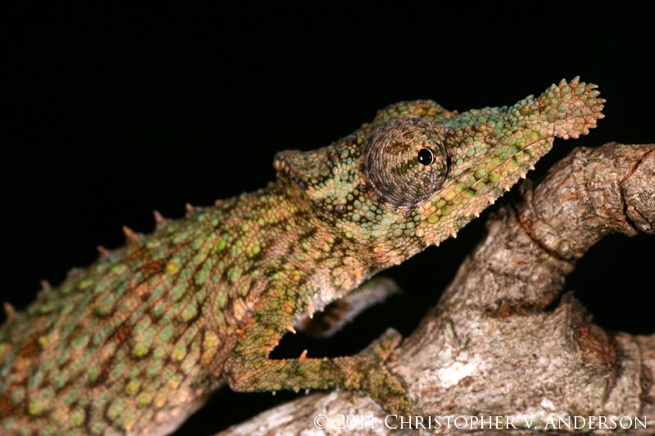



The Trade Status of Rhampholeon spinosus
By Christopher V. Anderson, PhD
Citation:
Anderson, C.V. (2014). The Trade Status of Rhampholeon spinosus. Chameleons! Online E-Zine, June 2014. (http://www.chameleonnews.com/14JunAndersonSpinosus.html)
Introduction
The Rossette-nosed or Usambara Spiny Pygmy Chameleon (Rhampholeon spinosus) is a beautiful, small chameleon species from the East and West Usambara Mountains in Tanzania. It is classified as Endangered by the IUCN Red List of Threatened Species (Mariaux 2010), and is a CITES Appendix II species (UNEP-WCMC 2013b, 2014a; UNEP 2014). Unfortunately this species has been subjected to outrageous levels of illegal trade in recent years, in large part due to confusion surrounding its CITES status (Anderson, personal observation; “ChrisZ” 2013; Fradl 2013; Rich 2013; Van Overbeke 2013, 2014; Bíró 2014). This confusion is the result of a taxonomic change now listing this species in a genus that is not otherwise listed by CITES, however CITES itself does not recognize this taxonomic change and thus still considers this a species of a genus that is listed. In an effort to clarify the trade status and plight of this species, this article will outline the underlying issues surrounding the trade status of this species. I hope this will encourage responsible practices regarding the trade in this species and help put an end to what is undoubtedly non-sustainable harvest due to illegal collection.

Taxonomic History
This species was originally described in 1892 from the Usambara Mountains of Tanzania as Chamaeleon spinosus (Matschie 1892). Later works referred to this species as Chamaeleo spinosus, as the official spelling of the genus was changed (Mertens 1966).
In 1986, based on it hemipenal morphology, geographic range, and lung morphology, the species was transferred to the genus Bradypodion, becoming known as Bradypodion spinosum (Klaver & Böhme 1986). In this taxonomic revision of the family, this species was placed in the now defunct subgenus Chamaeleoninae based on the absence of particular ornamentation on the hemipenis. It was then placed in the genus Bradypodion based on its mainland African distribution and a lack of large longitudinal septa in the lungs.
In 2004, however, the species was re-evaluated based on genetic data, hemipenal morphology and cranial morphology (Tilbury & Mariaux 2004). Based on this review, the species was placed in the genus Rhampholeon as Rhampholeon spinosus. Shortly thereafter, genetic and morphological data determined that it was more specifically a member of the Rhampholeon subgenus, and thus is most accurately known as Rhampholeon (Rhampholeon) spinosus (Mariaux & Tilbury 2006).

Conservation Status
This taxon is regarded as a rare and restricted species (Tilbury, 2010) and has been assessed as Endangered by the IUCN Red List of Threatened Species (Mariaux 2010). It has been classified as Endangered because its extent of occurrence is estimated to be less than 5000 km2, it is known to occur at only two locations (East and West Usambara Mountains), and is experiencing continuing decline in the extent and/or quality of habitat (Mariaux 2010). Given its uncommon status, this species has only been issued export quotas for a limited number of F1 individuals rather than allowing collection and export of wild caught animals (CITES 2014). Further, given its restricted range and rare status, this species is unlikely to be able to withstand collection pressures from uncontrolled export of wild collected specimens.
CITES Status
In 1977 the genus Chamaeleo was added to CITES Appendix II (UNEP-WCMC 2013a; UNEP 2014), meaning that international trade in all members of the genus were subject to monitoring and regulation that require CITES permits to be issued for all international transport. With the recognition of the genus Bradypodion by CITES, all members of that genus were similarly included as CITES Appendix II due to their previous inclusion in the genus Chamaeleo (UNEP-WCMC, 2013a; UNEP 2014). Currently, CITES does not explicitly list any Rhampholeon species on any appendix of CITES (UNEP-WCMC 2013a, 2013b).
With that said, CITES has not adopted the taxonomic change switching Bradypodion spinosum to Rhampholeon spinosus (UNEP-WCMC 2013b, 2014a; UNEP 2014). As a result, for CITES purposes, this species is still considered Bradypodion spinosum. Thus, based on its previous classification as Chamaeleo spinosus and later Bradypodion spinosum, this taxon has been uninterruptedly included as a CITES Appendix II species since 1977 (UNEP-WCMC 2013a, 2013b, 2014a; UNEP 2014).
Even if CITES had adopted the taxonomic change for this species to Rhampholeon, however, a species does not lose its CITES standing based on a change in taxonomy. If this were the case, species like elephants and rhinoceros would be subject to constant taxonomic changes in an attempt to circumvent their protected status. Instead, the result of CITES accepting the taxonomic change of this species to Rhampholeon spinosus would simply be that it could no longer be said that no Rhampholeon species was CITES listed. Thus, even if Rhampholeon spinosus is regarded as the accurate classification for this taxon, it remains a CITES Appendix II species.

Trade History
Between 2000 and 2011, this taxon was issued annual CITES export quotas ranging from 8-50 (25 average) captive born (F1) individuals per year from Tanzania (CITES 2014). In the years from 2012 through 2014, however, no annual quota was issued for this species (CITES 2014). Between 1977 and 2013 a total of 149 live individuals were imported from Tanzania for the pet trade (total of all personal and commercial imports reported from Tanzania) (UNEP-WCMC 2014b). All of these imports occurred between 1993 and 2011, with all but 11 individuals having been imported between 2001 and 2011 (UNEP-WCMC 2014b).
Current Trade Issues
Given that Rh. spinosus is still a CITES Appendix II species (UNEP-WCMC 2013a, 2013b, 2014a; UNEP 2014) and that the Tanzanian Management Authority, which utilizes annual CITES export quotas to manage its trade in CITES species, did not issue quotas for this species in 2012, 2013 or 2014 (CITES 2014), no Rh. spinosus should have been able to be legally exported from Tanzania during those years. Over this period and a number of years leading up to it, however, this species has experienced a boom in trade (Anderson, personal observation; “ChrisZ” 2013; Fradl 2013; Rich 2013; Van Overbeke 2013, 2014; Bíró 2014). In particular, specimens of this species are known to have been imported numerous times and in large numbers (hundreds, if not thousands) among shipments of “assorted pygmy chameleon” (i.e. Rhampholeon sp.) without accompanying CITES documents (Anderson, personal observation), suggesting that illegal trade and/or harvest is likely occurring at significant levels.

Conclusions
As documented above, Rhampholeon spinosus is an endangered species that is currently listed on Appendix II of CITES with no annual export quotas issued since 2011. Due to confusion about its classification, however, this species is being illegally exported from Tanzania by the hundreds, if not thousands. Exporters in Tanzania and importers in Europe, the US and Asia have utilized the ambiguity surrounding the CITES status of this species to exploit the taxon at outrageous levels. Whether this is being done intentionally (knowingly) or unintentionally (not knowing the taxonomic history and protection status) isn’t clear, however its success depends on enforcement agencies not knowing any better, and more importantly, importers who either also don’t know any better or are willing to violate international laws for their own greed and in the process risk their entire shipments being confiscated.
As hobbyists, you can make a difference in protecting this species from illegal trade by informing importers of the legal status of this species if they appear to be preparing to receive or order individuals of this species, and by making sure wildlife authorities are notified about dubious importation of this species. If their shipments are legal, they will have the CITES documentation to prove it, and any investigation by wildlife authorities will quickly determine that. If not, they are part of the problem and continuing to allow them to exploit this species may not only jeopardize the survival of this species, but may also result in additional restrictions to our hobby. Our hobby should be pursued responsibly and in a sustainable manner, but the current situation with Rhampholeon spinosus is anything but.

References
Bíró, J. 2014. József Bíró, mypet.hu, in litt. To Facebook, 4/26/14. < https://www.facebook.com/permalink.php?story_fbid=616578918439172&id=100002612098598> and < https://www.facebook.com/photo.php?fbid=616577145106016&set=pcb.616578918439172&type=1&theater>. Downloaded on 17 June 2014.
“ChrisZ”. 2013. “ChrisZ” in litt. To ChameleonForums, 12/8/13. <http://www.chameleonforums.com/rhampoleon-spinosum-122120/>. Downloaded on 17 June 2014.
Convention on International Trade in Endangered Species of Wild Fauna and Flora (CITES). 2014. CITES Export Quotas. <http://www.cites.org/eng/resources/quotas/index.php>. Downloaded on 17 June 2014.
Fradl, A. 2013. “coldbloodedAL” in litt. To ChameleonForums, 12/9/13. <http://www.chameleonforums.com/rhampoleon-spinosum-122120/index2.html#post1077822>. Downloaded on 17 June 2014.
Klaver, C. and Böhme, W. 1986. Phylogeny and classification of the Chamaeleonidae (Sauria) with special reference to hemipenis morphology. Bonn Zool. Monogr. 22: 1-64.
Mariaux, J. 2010. Rhampholeon spinosus. In: IUCN 2014. IUCN Red List of Threatened Species. Version 2014.1. <www.iucnredlist.org>. Downloaded on 17 June 2014.
Mariaux, J. and Tilbury, C.R. 2006. The pygmy chameleons of the Eastern Arc Range (Tanzania): Evolutionary relationships and the description of three new species of Rhampholeon (Sauria: Chamaeleonidae). Herpetol. J. 16 (3): 315-331.
Matschie, P. 1892. Über eine kleine Sammlung von Säugethieren und Reptilien, welche Herr L. Conradt aus Usambara (Deutsch Ostafrika) heimgebracht hat. Sber. Ges. naturf. Freunde, Berlin 1892: 101-110.
Mertens, R. 1966. Chamaeleonidae. Das Tierreich 83: 1-37.
Rich, J.A. 2013. “Motherlode Chameleon” in litt. To ChameleonForums, 6/16/13. < http://www.chameleonforums.com/rhampholeon-spinosus-112473/>. Downloaded on 17 June 2014.
Tilbury, C. 2010. Chameleons of Africa: An Atlas including the chameleons of Europe, the Middle East and Asia. Edition Chimaira, Frankfurt am Main, Germany. 831 pp.
Tilbury, C.R. and Mariaux, J. 2004. A re-evaluation of the generic assignment of Bradypodion spinosum (Matschie, 1892) and some considerations on the genus Rhampholeon Günther, 1874. Rev. Suisse Zool. 111 (1): 103-110.
UNEP. 2014. Bradypodion spinosum. In: The Species+ Website. Nairobi, Kenya. Compiled by UNEP-WCMC, Cambridge, UK. <www.speciesplus.net>. Downloaded on 17 June 2014.
UNEP-WCMC. 2013a. History of CITES Listings. CITES Secretariat, Geneva, Switzerland and UNEP-WCMC, Cambridge, United Kingdom. Downloaded on 17 June 2014.
UNEP-WCMC. 2013b. Index of CITES Species. CITES Secretariat, Geneva, Switzerland and UNEP-WCMC, Cambridge, United Kingdom. Downloaded on 17 June 2014.
UNEP-WCMC. 2014a. Bradypodion spinosum. In: Checklist of CITES Species. <http://checklist.cites.org/>. Downloaded on 17 June 2014.
UNEP-WCMC. 2014b. Bradypodion spinosum. In: CITES Trade Database. <http://trade.cites.org>. Downloaded on 17 June 2014.
Van Overbeke, J. 2013. “kameleons jvo” in litt. To ChameleonForums, 6/18/13. < http://www.chameleonforums.com/rhampholeon-spinosus-112473/index2.html#post1009899>. Downloaded on 17 June 2014.
Van Overbeke, J. 2014. “kameleons jvo” in litt. To ChameleonForums, 4/9/13. < http://www.chameleonforums.com/acuminatus-viridis-kerstenii-spinosus-128104/>. Downloaded on 17 June 2014.

Christopher V. Anderson, PhD

Chris Anderson has a Ph.D. in Biology (Physiology & Morphology) from the University of South Florida’s Department of Integrative Biology, where he studied the effects of temperature on ballistic tongue projection and tongue retraction in chameleons for his dissertation. Currently a Postdoctoral Researcher at Brown University, Chris is also a member of the IUCN/SSC Chameleon Specialist Group. His chameleon research has been published in top scientific journals and books, and the results have been featured in popular press and news outlets all over the world. He has traveled extensively to chameleon habitats around the world, including conducting work with chameleons in Madagascar, South Africa and Cameroon, as well as introduced populations in Florida. Further, Chris has been keeping chameleons since 1997, and since then has worked with over 70 different species and subspecies in captivity. Currently, Chris is the Editor and Webmaster of the Chameleons! Online E-Zine. Chris’ personal website can be found at www.chamaeleonidae.com and he can be emailed at either Chris.Anderson@chameleonnews.com or Furcifer.minor@gmail.com.









Join Our Facebook Page for Updates on New Issues:
© 2002-2014 Chameleonnews.com All rights reserved.
Reproduction in whole or part expressly forbidden without permission from the publisher. For permission, please contact the editor at editor@chameleonnews.com
